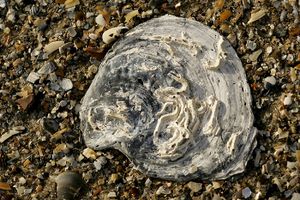Pollution and zoobenthos
Benthic communities are particularly vulnerable to pollutants because they have very limited mobility. [1] Contaminants are usually associated to particles. These particles are often very small, and can therefore stay in solution for a very long time. Nevertheless, concentrations of heavy metals in the soil are often 10 to 100 times higher than those in solution. They can become biologically available when benthic organisms eat them. [2] Metals in soils can also become more available for uptake by zoobenthos due to changing physico chemical processes. [3] Because of their limited mobility, benthic communities are of special interest for monitoring pollutants. Changing concentrations of pollutants in zoobenthos typically reflect changes in the local environment. This is because, although zoobenthos acquire pollutants through food, most of the pollutants contaminate the animals directly; they are adsorbed to its tissue while the animal acquires oxygen. Particularly mussels (the mussel watch program) have been widely used as a bioindicator to detect trends in pollutant concentrations. [2]
TBT
Many zoobenthos species have been effected by the extensive use of TBT in antifouling paints. Because TBT can seriously affect their reproduction, its use nearly caused the collapse of oyster farms of Arcachon bay in France in the 1970s. [4] In gastropods, TBT is known to cause imposex; the presence of male reproductive organs in females, which causes female sterility. These effects caused many gastropod species to became locally extinct in the Wadden Sea and the Eastern Scheldt bay. Eventually this resulted in an international ban to apply TBT on ships starting from 2003, and the obligation to remove all TBT on ships by 2008. [5] [6]
Below you can find some links to Belgian case studies on ecotoxicology in zoobenthos.
Case studies
Case study 1: Heavy metal content of mussels in the Western Scheldt estuary[7]
Case study 2: Heavy metals in various Belgian benthic invertebrates[3]
Case study 3: Effects of heavy metals on the sperm quality and the larvae survival of sea urchins[8]
Case study 4: Effects of copper-based antifouling paints on brine shrimp[4]
Case study 5: TBT and intersex in periwinkles[5]
Case study 6: Levels of PCBs and organochlorine pesticides in various benthic species in the Belgian North sea and the Western Scheldt estuary[9]
Case study 7: PCBs and organochlorine pesticides in shrimp from the Belgian North Sea[10]
Case study 8: Flame retardants organotin compounds and surfactants in opossum shrimps of the Scheldt estuary.[11]
Case study 9: Effects of endocrine disrupting compounds on embryonic development of opossum shrimps.[12]
Case study 10: Effects of methoprene, nonylphenol and estrone on the vitellogenin production of opossum shrimp[13]
References
- ↑ Kennish M. J., (1998), Pollution impacts on marine biotic communities CRC Press 310 pp
- ↑ 2.0 2.1 Elliot, M.; Hemingway, K. (2002). Fishes in estuaries. Blackwell Science: London, UK. 636 pp.
- ↑ 3.0 3.1 Guns, M.; Van Hoeyweghen, P.; Vyncke, W.; Hillewaert, H. (1999). Trace metals in selected benthic invertebrates from Belgian coastal waters (1981 - 1996). Marine pollution bulletin, Vol 38 No. 12 pp. 1184-1193. Cite error: Invalid
<ref>tag; name "gu" defined multiple times with different content - ↑ 4.0 4.1 Katranitsas, A.; Castritsi-Catharios, J.; Persoone, G. (2003). The effects of a copper-based antifouling paint on mortality and enzymatic activity of a non-target marine organism. Mar. Pollut. Bull. 46(11): 1491-1494
- ↑ 5.0 5.1 De Wolf, H.; Handa, C.; Backeljau, T.; Blust, R. (2004). A baseline survey of intersex in Littorina littorea along the Scheldt Estuary, The Netherlands. Mar. Pollut. Bull. 48(5-6): 592-596
- ↑ Md. Shahidul Islam and Masaru Tanaka, 2004, Impacts of pollution on coastal and marine ecosystems including coastal and marine fisheries and approach for management: a review and synthesis, Marine Pollution Bulletin Volume 48, 7-8 Pages 624-649.
- ↑ Mubiana, V.K.; Blust, R. (2006). Metal content of marine mussels from Western Scheldt Estuary and nearby protected Marine Bay, the Netherlands: impact of past and present contamination. Bull. Environ. Contam. Toxicol. 77(2): 203-210
- ↑ Warnau, M.; Iaccarino, M.; De Biase, A.; Temara, A.; Jangoux, M.; Dubois, Ph.; Pagano, G. (1996). Spermiotoxicity and embryotoxicity of heavy metals in the echinoid Paracentrotus lividus. Environ. Toxicol. Chem. 15(11): 1931-1936
- ↑ Voorspoels, S.; Covaci, A.; Maervoet, J.; De Meester, I.; Schepens, P. (2004). Levels and profiles of PCBs and OCPs in marine benthic species from the Belgian North Sea and the Western Scheldt Estuary. Mar. Pollut. Bull. 49(5-6): 393-404
- ↑ Raemaekers, M.; Derveaux, S.; Parmentier, K. (2006). Polychlorinated biphenyls and organochlor pesticides in brown shrimp (Crangon crangon) of the Belgian Continental Shelf, in: Luten, J.B. et al. (Ed.) (2006). Seafood research from fish to dish: quality, safety and processing of wild and farmed fish. pp. 489-496
- ↑ Verslycke, T.; Vethaak, A.D.; Arijs, K.; Janssen, C.R. (2004). Flame retardants, surfactants and organotins in sediment and mysid shrimp of the Scheldt estuary (The Netherlands). Environ. Poll. 136(1): 19-31
- ↑ Ghekiere, A.; Fockedey, N.; Verslycke, T.; Vincx, M.; Janssen, C.R. (2007). Marsupial development in the mysid Neomysis integer (Crustacea: Mysidacea) to evaluate the effects of endocrine-disrupting chemicals. Ecotoxicol. Environ. Saf. 66(1): 9-15
- ↑ Ghekiere, A.; Verslycke, T.; Janssen, C.R. (2006). Effects of methoprene, nonylphenol, and estrone on the vitellogenesis of the mysid Neomysis integer. Gen. Comp. Endocrinol. 147(2): 190-195
Please note that others may also have edited the contents of this article.
|
